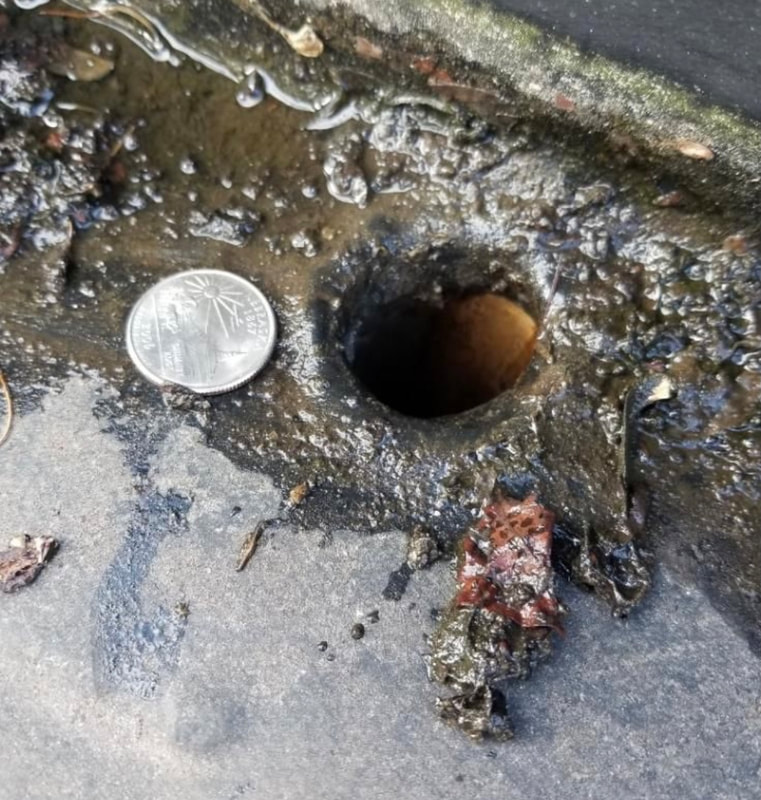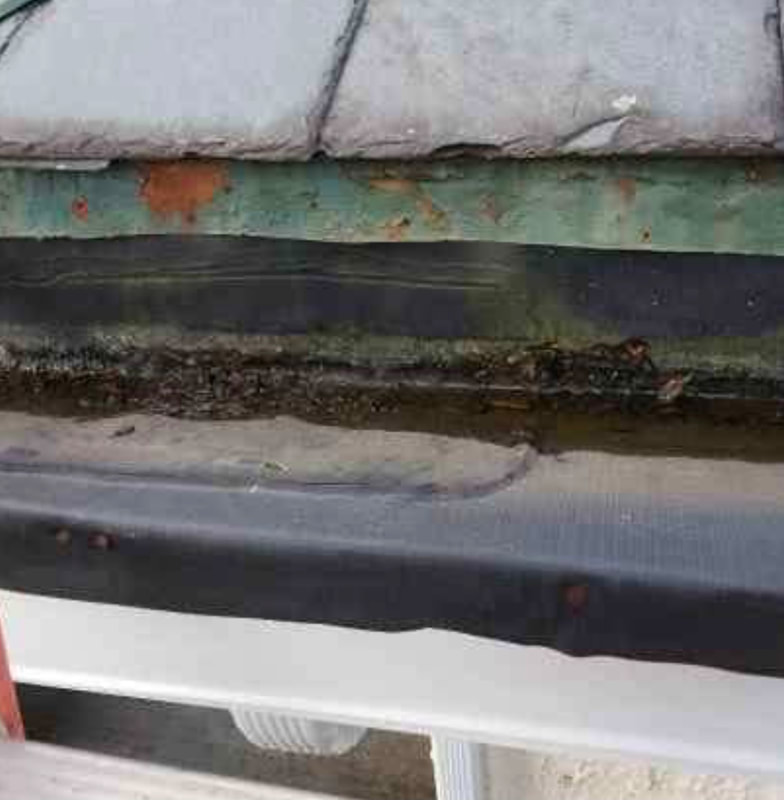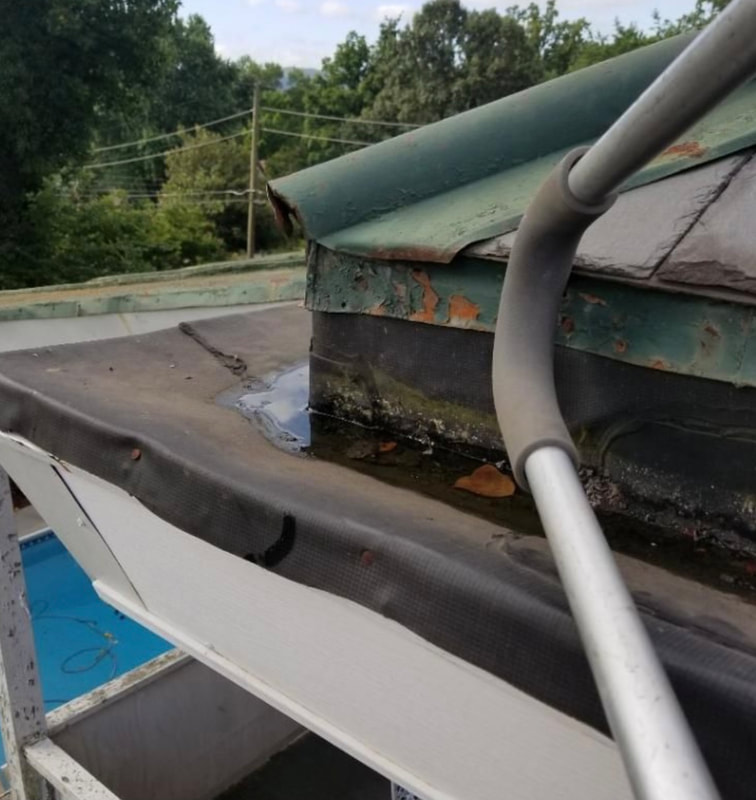Death of Historic Homes via Hidden Gutters
Ronny and his team at Blue Glass, LLC have been helping homeowners solve their historic home challenges since 2004.
What you don’t know, can actually hurt you. Educate yourself about hidden gutters before letting someone “fix” them.
The Life/Death cycle of most older hidden gutters:
1. Time of construction: Built well (hopefully with expansion joints for the metal to move, but usually not). Tin, folded and soldered at the joints and kept well painted with compatible lead paint for 30 years. Downspout material is the same as the gutter to avoid galvanic reaction.
2. The Great Depression or War arrives 20 - 30 years later: Maintenance stops, paint peels, creating thousands of tiny ponds that begin to rust the hidden gutter metal, leak, rot the soffit boards and supporting framework of the hidden gutter.
3. Homeowner hires painter to paint over the ugly rotten soffit spots regularly.
4. 50 years after original construction, the hidden gutter is poorly replaced. The contractor short cuts the process by trying not to remove the first few rows of slate (notice the hand cut metal hanging a couple inches below the slate). Repairs to the support members have been ignored. The soffit/gutter support members are still sagging due to the leaks. Water now must be an inch or two deep before it flows to the downspout location. Sometimes the new contractor uses “beautiful” copper but does not build in expansion joints and the soldered seams crack in 5 years (taking us back to stage 2, but $40,000 poorer).
5. Water begins running over the hidden gutter at low spots around the house. This eventually makes the basement wet and moldy. Oftentimes these runovers occur at porch column locations and rots out the column bases or porch floor, lowering the porch and accelerating the damage.
6. 10 years later the failing process repeats more rapidly.
7. The homeowner gets tired of the continually peeling soffit paint and often installs aluminum or vinyl soffit to hide the damage and reduce expenses “once and for all”. They spend thousands to fix their rotten posts but don’t fix the gutter cause.
8. The “new” hidden gutter leaks are accelerated by roof repair folks walking in the hidden gutter (stressing the weak solder joints). This is especially true in the thin rusted areas because the gutter’s wooden support structure has rotted away in many areas.
9. By 1980, the flat roof tar guys often show up and coat the leaky spots.
10. 1985 they realize that tar cracks, the gutters still leak, and new “technicians” begin putting fabric/fiberglass in the mixture to make it last longer. The same guys add a metal piece the outer lip of the gutter so the water can get deep enough to flow to the downspout. Now, the gutter becomes a series of ponds until the sun dries everything. In the meantime, the tin gutter rusting away accelerates again.
11. By the year 2000, flat roof guys begin re-“fixing” the hidden gutter by band-aiding it with a rubber membrane (which in the small print says is not suitable for “ponding” water). Their “fix” reduces the downspout hole to coin size in some locations and puts an elevated lip around the downspout opening as well. From the ground, things look nice because the homeowner has replaced those rusted ugly downspouts with beautiful aluminum. Sometimes the hidden gutters are painted with the latest, greatest, everything miracle fix but the metal cannot be prepared well enough for it to last, so the contractor just slops everything on thicker and leaves with your money (thinking they did a good job).
12. The downspout clogs easily with a few leaves and the water runs over the gutter all over again. Our phone rings. “Hi, I’d like a quote for y’all to come fix my hidden gutters.”
Summary:
Replacing a hidden gutter properly is about the most expensive project on any home. Many new “historic” homeowners get shocked, “That’s more than I paid for my house. I can’t afford that.”
We totally understand. I don’t enjoy giving folks bad news at all, so hopefully this will get passed around enough to educate people BEFORE they feel trapped by their old home purchase.
Old homes are gorgeous and the craftsmanship of the stairway to the attic often exceeds anything in a newer home. Take time to become educated before you hire someone to “fix” your hidden gutters. Hiring the wrong company just makes you poorer and frustrated when they are rehired in 7 years to put rubber patches on the leaking solder joints of your expensive, new, copper hidden gutter system.
The time consuming work of replacing/rebuilding hidden gutters is generally high above the ground, requires specific skilled labor (or the cycle repeats), requires scaffolding, lots of slate repair, lots of structural work to replace the rotten and/or missing soffit/gutter supports and any suitable metal material is very expensive as well.
If you are a homeowner, ask for references, go look at the contractor’s work, require photo documentation of the work performed properly at multiple stages in the contract. Require expansion joints to be built according to National Slate Association or Slate Roofing Contractors Association specifications. Failure to produce photo documentation at any stage and the money stops until the work must be undone. Don’t expect a free estimate. All the good contractors are happy to help you, but they remain extremely busy and their time is precious to them as well.
A good hidden gutter system should last as long as a new slate roof. A well built slate roof may last 100 - 150 years. If your slate is nearing its life expectancy, or has been muddled up by "roof walkers" and needs maintenance frequently, consider replacing the entire slate roof at the same time the hidden gutters are properly rebuilt.
If the roof or gutter leaks, the home will be a continual headache and expense. Once done properly, not only will your home be on a path to a safe recovery, its value will increase significantly over time.
The Life/Death cycle of most older hidden gutters:
1. Time of construction: Built well (hopefully with expansion joints for the metal to move, but usually not). Tin, folded and soldered at the joints and kept well painted with compatible lead paint for 30 years. Downspout material is the same as the gutter to avoid galvanic reaction.
2. The Great Depression or War arrives 20 - 30 years later: Maintenance stops, paint peels, creating thousands of tiny ponds that begin to rust the hidden gutter metal, leak, rot the soffit boards and supporting framework of the hidden gutter.
3. Homeowner hires painter to paint over the ugly rotten soffit spots regularly.
4. 50 years after original construction, the hidden gutter is poorly replaced. The contractor short cuts the process by trying not to remove the first few rows of slate (notice the hand cut metal hanging a couple inches below the slate). Repairs to the support members have been ignored. The soffit/gutter support members are still sagging due to the leaks. Water now must be an inch or two deep before it flows to the downspout location. Sometimes the new contractor uses “beautiful” copper but does not build in expansion joints and the soldered seams crack in 5 years (taking us back to stage 2, but $40,000 poorer).
5. Water begins running over the hidden gutter at low spots around the house. This eventually makes the basement wet and moldy. Oftentimes these runovers occur at porch column locations and rots out the column bases or porch floor, lowering the porch and accelerating the damage.
6. 10 years later the failing process repeats more rapidly.
7. The homeowner gets tired of the continually peeling soffit paint and often installs aluminum or vinyl soffit to hide the damage and reduce expenses “once and for all”. They spend thousands to fix their rotten posts but don’t fix the gutter cause.
8. The “new” hidden gutter leaks are accelerated by roof repair folks walking in the hidden gutter (stressing the weak solder joints). This is especially true in the thin rusted areas because the gutter’s wooden support structure has rotted away in many areas.
9. By 1980, the flat roof tar guys often show up and coat the leaky spots.
10. 1985 they realize that tar cracks, the gutters still leak, and new “technicians” begin putting fabric/fiberglass in the mixture to make it last longer. The same guys add a metal piece the outer lip of the gutter so the water can get deep enough to flow to the downspout. Now, the gutter becomes a series of ponds until the sun dries everything. In the meantime, the tin gutter rusting away accelerates again.
11. By the year 2000, flat roof guys begin re-“fixing” the hidden gutter by band-aiding it with a rubber membrane (which in the small print says is not suitable for “ponding” water). Their “fix” reduces the downspout hole to coin size in some locations and puts an elevated lip around the downspout opening as well. From the ground, things look nice because the homeowner has replaced those rusted ugly downspouts with beautiful aluminum. Sometimes the hidden gutters are painted with the latest, greatest, everything miracle fix but the metal cannot be prepared well enough for it to last, so the contractor just slops everything on thicker and leaves with your money (thinking they did a good job).
12. The downspout clogs easily with a few leaves and the water runs over the gutter all over again. Our phone rings. “Hi, I’d like a quote for y’all to come fix my hidden gutters.”
Summary:
Replacing a hidden gutter properly is about the most expensive project on any home. Many new “historic” homeowners get shocked, “That’s more than I paid for my house. I can’t afford that.”
We totally understand. I don’t enjoy giving folks bad news at all, so hopefully this will get passed around enough to educate people BEFORE they feel trapped by their old home purchase.
Old homes are gorgeous and the craftsmanship of the stairway to the attic often exceeds anything in a newer home. Take time to become educated before you hire someone to “fix” your hidden gutters. Hiring the wrong company just makes you poorer and frustrated when they are rehired in 7 years to put rubber patches on the leaking solder joints of your expensive, new, copper hidden gutter system.
The time consuming work of replacing/rebuilding hidden gutters is generally high above the ground, requires specific skilled labor (or the cycle repeats), requires scaffolding, lots of slate repair, lots of structural work to replace the rotten and/or missing soffit/gutter supports and any suitable metal material is very expensive as well.
If you are a homeowner, ask for references, go look at the contractor’s work, require photo documentation of the work performed properly at multiple stages in the contract. Require expansion joints to be built according to National Slate Association or Slate Roofing Contractors Association specifications. Failure to produce photo documentation at any stage and the money stops until the work must be undone. Don’t expect a free estimate. All the good contractors are happy to help you, but they remain extremely busy and their time is precious to them as well.
A good hidden gutter system should last as long as a new slate roof. A well built slate roof may last 100 - 150 years. If your slate is nearing its life expectancy, or has been muddled up by "roof walkers" and needs maintenance frequently, consider replacing the entire slate roof at the same time the hidden gutters are properly rebuilt.
If the roof or gutter leaks, the home will be a continual headache and expense. Once done properly, not only will your home be on a path to a safe recovery, its value will increase significantly over time.


